Customer Relationship Management Systems
VerifiedAdded on 2020/01/15
|13
|4891
|380
AI Summary
This assignment requires a comprehensive literature review exploring the effectiveness of electronic customer relationship management (CRM) systems. Students need to analyze existing research papers and studies to understand the impact, benefits, challenges, and future trends associated with implementing CRM systems in businesses. The review should encompass various aspects of CRM, including its role in enhancing customer satisfaction, loyalty, and retention.
Contribute Materials
Your contribution can guide someone’s learning journey. Share your
documents today.
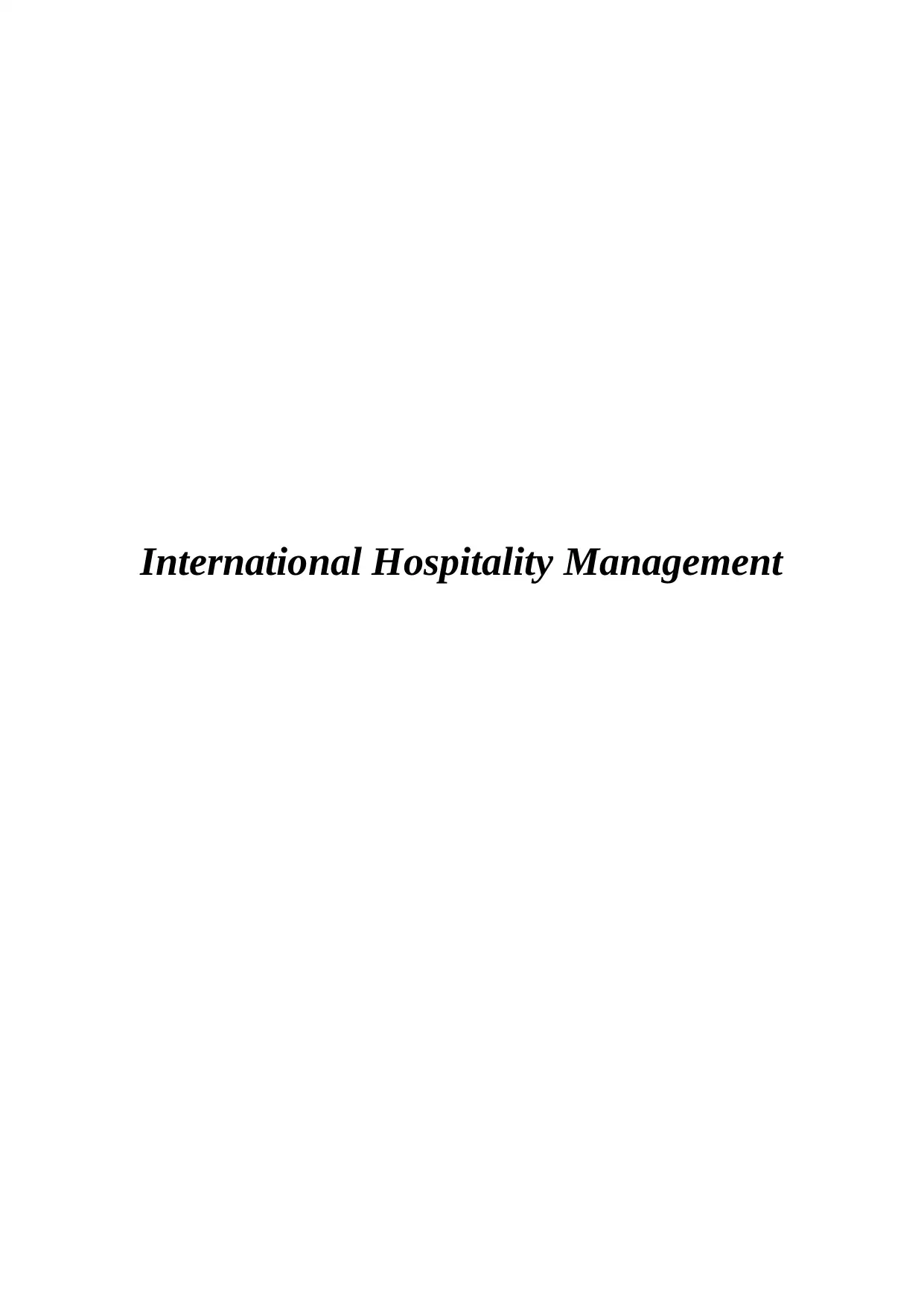
International Hospitality Management
Secure Best Marks with AI Grader
Need help grading? Try our AI Grader for instant feedback on your assignments.
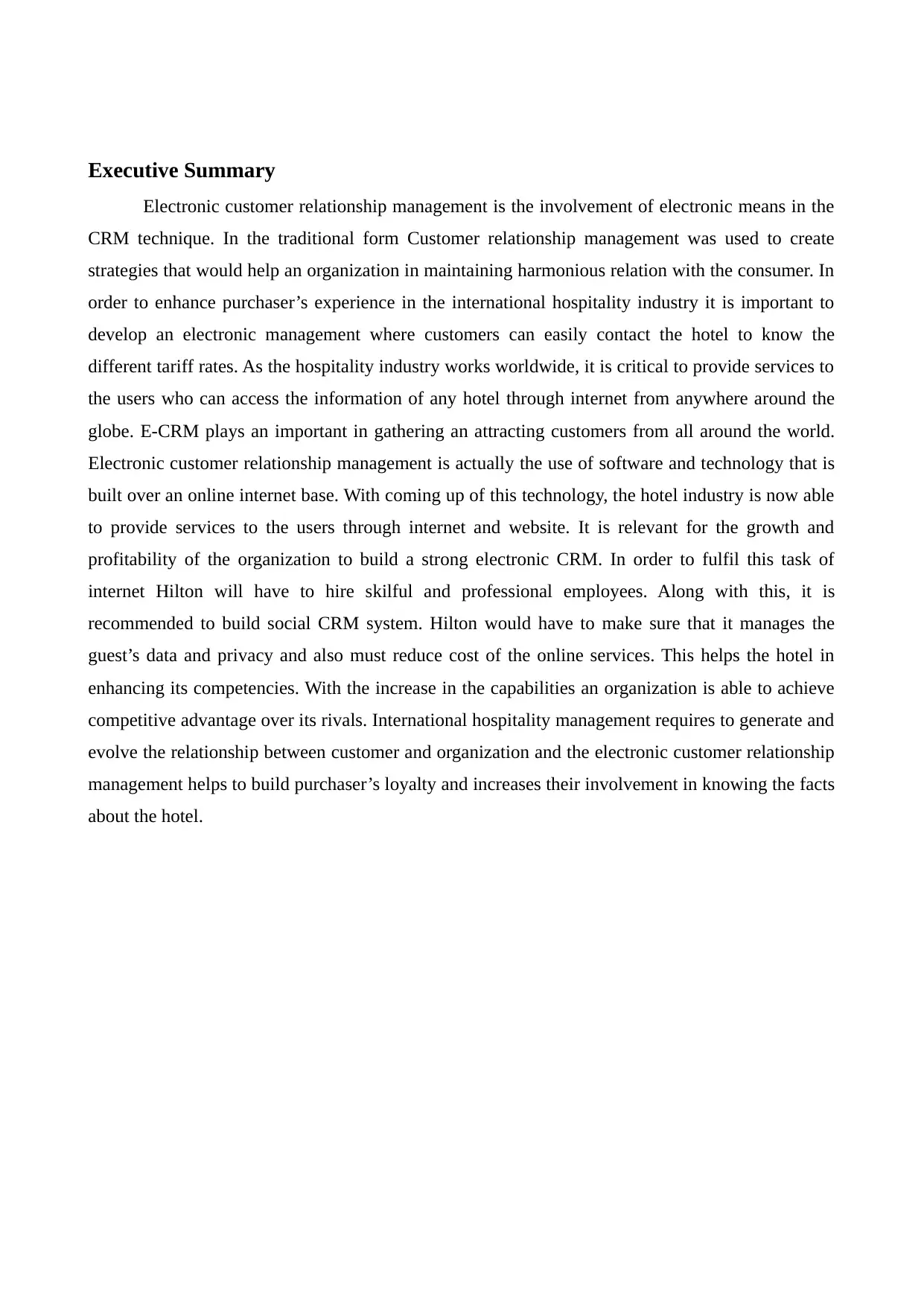
Executive Summary
Electronic customer relationship management is the involvement of electronic means in the
CRM technique. In the traditional form Customer relationship management was used to create
strategies that would help an organization in maintaining harmonious relation with the consumer. In
order to enhance purchaser’s experience in the international hospitality industry it is important to
develop an electronic management where customers can easily contact the hotel to know the
different tariff rates. As the hospitality industry works worldwide, it is critical to provide services to
the users who can access the information of any hotel through internet from anywhere around the
globe. E-CRM plays an important in gathering an attracting customers from all around the world.
Electronic customer relationship management is actually the use of software and technology that is
built over an online internet base. With coming up of this technology, the hotel industry is now able
to provide services to the users through internet and website. It is relevant for the growth and
profitability of the organization to build a strong electronic CRM. In order to fulfil this task of
internet Hilton will have to hire skilful and professional employees. Along with this, it is
recommended to build social CRM system. Hilton would have to make sure that it manages the
guest’s data and privacy and also must reduce cost of the online services. This helps the hotel in
enhancing its competencies. With the increase in the capabilities an organization is able to achieve
competitive advantage over its rivals. International hospitality management requires to generate and
evolve the relationship between customer and organization and the electronic customer relationship
management helps to build purchaser’s loyalty and increases their involvement in knowing the facts
about the hotel.
Electronic customer relationship management is the involvement of electronic means in the
CRM technique. In the traditional form Customer relationship management was used to create
strategies that would help an organization in maintaining harmonious relation with the consumer. In
order to enhance purchaser’s experience in the international hospitality industry it is important to
develop an electronic management where customers can easily contact the hotel to know the
different tariff rates. As the hospitality industry works worldwide, it is critical to provide services to
the users who can access the information of any hotel through internet from anywhere around the
globe. E-CRM plays an important in gathering an attracting customers from all around the world.
Electronic customer relationship management is actually the use of software and technology that is
built over an online internet base. With coming up of this technology, the hotel industry is now able
to provide services to the users through internet and website. It is relevant for the growth and
profitability of the organization to build a strong electronic CRM. In order to fulfil this task of
internet Hilton will have to hire skilful and professional employees. Along with this, it is
recommended to build social CRM system. Hilton would have to make sure that it manages the
guest’s data and privacy and also must reduce cost of the online services. This helps the hotel in
enhancing its competencies. With the increase in the capabilities an organization is able to achieve
competitive advantage over its rivals. International hospitality management requires to generate and
evolve the relationship between customer and organization and the electronic customer relationship
management helps to build purchaser’s loyalty and increases their involvement in knowing the facts
about the hotel.
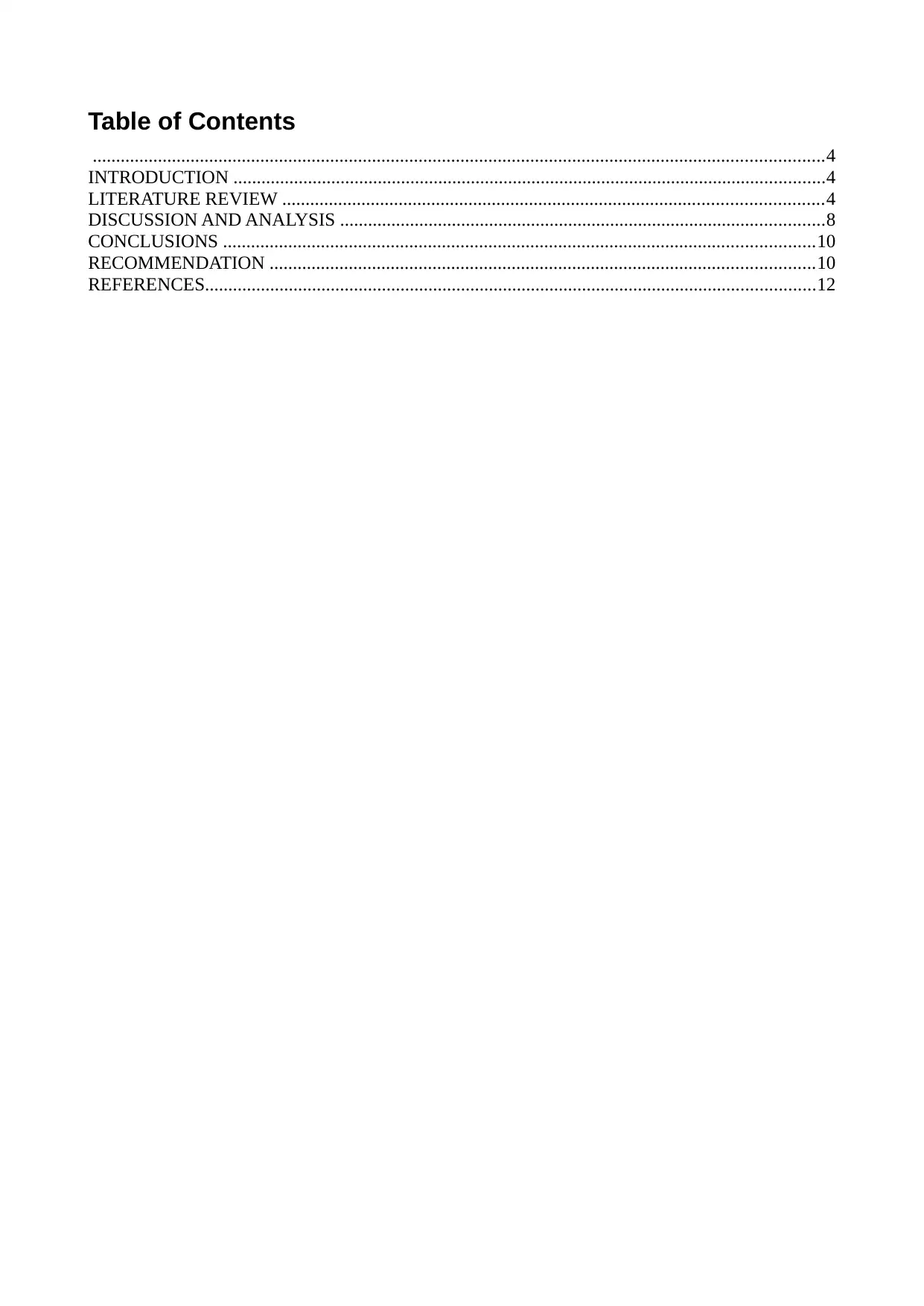
Table of Contents
.............................................................................................................................................................4
INTRODUCTION ...............................................................................................................................4
LITERATURE REVIEW ....................................................................................................................4
DISCUSSION AND ANALYSIS ........................................................................................................8
CONCLUSIONS ...............................................................................................................................10
RECOMMENDATION .....................................................................................................................10
REFERENCES...................................................................................................................................12
.............................................................................................................................................................4
INTRODUCTION ...............................................................................................................................4
LITERATURE REVIEW ....................................................................................................................4
DISCUSSION AND ANALYSIS ........................................................................................................8
CONCLUSIONS ...............................................................................................................................10
RECOMMENDATION .....................................................................................................................10
REFERENCES...................................................................................................................................12
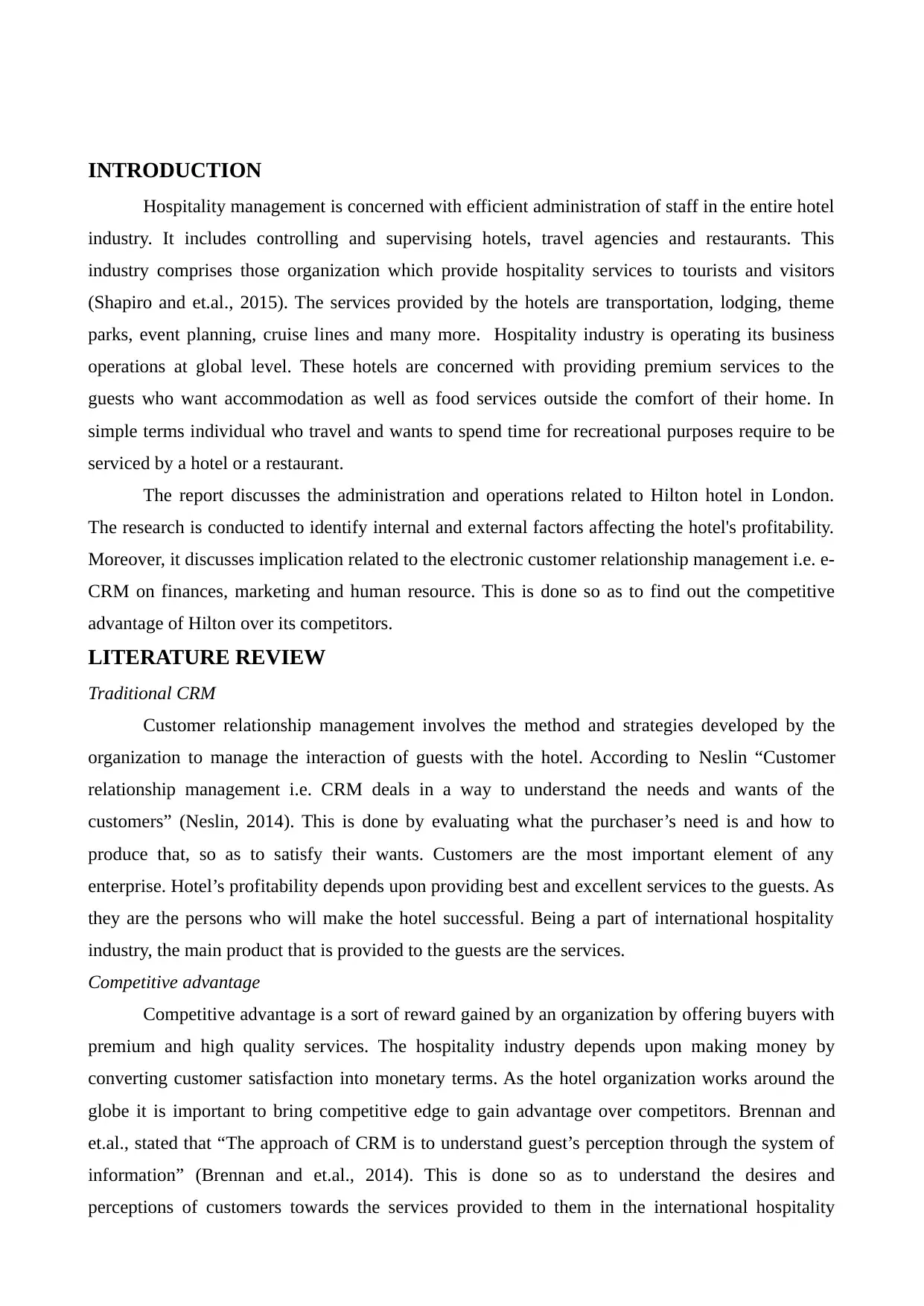
INTRODUCTION
Hospitality management is concerned with efficient administration of staff in the entire hotel
industry. It includes controlling and supervising hotels, travel agencies and restaurants. This
industry comprises those organization which provide hospitality services to tourists and visitors
(Shapiro and et.al., 2015). The services provided by the hotels are transportation, lodging, theme
parks, event planning, cruise lines and many more. Hospitality industry is operating its business
operations at global level. These hotels are concerned with providing premium services to the
guests who want accommodation as well as food services outside the comfort of their home. In
simple terms individual who travel and wants to spend time for recreational purposes require to be
serviced by a hotel or a restaurant.
The report discusses the administration and operations related to Hilton hotel in London.
The research is conducted to identify internal and external factors affecting the hotel's profitability.
Moreover, it discusses implication related to the electronic customer relationship management i.e. e-
CRM on finances, marketing and human resource. This is done so as to find out the competitive
advantage of Hilton over its competitors.
LITERATURE REVIEW
Traditional CRM
Customer relationship management involves the method and strategies developed by the
organization to manage the interaction of guests with the hotel. According to Neslin “Customer
relationship management i.e. CRM deals in a way to understand the needs and wants of the
customers” (Neslin, 2014). This is done by evaluating what the purchaser’s need is and how to
produce that, so as to satisfy their wants. Customers are the most important element of any
enterprise. Hotel’s profitability depends upon providing best and excellent services to the guests. As
they are the persons who will make the hotel successful. Being a part of international hospitality
industry, the main product that is provided to the guests are the services.
Competitive advantage
Competitive advantage is a sort of reward gained by an organization by offering buyers with
premium and high quality services. The hospitality industry depends upon making money by
converting customer satisfaction into monetary terms. As the hotel organization works around the
globe it is important to bring competitive edge to gain advantage over competitors. Brennan and
et.al., stated that “The approach of CRM is to understand guest’s perception through the system of
information” (Brennan and et.al., 2014). This is done so as to understand the desires and
perceptions of customers towards the services provided to them in the international hospitality
Hospitality management is concerned with efficient administration of staff in the entire hotel
industry. It includes controlling and supervising hotels, travel agencies and restaurants. This
industry comprises those organization which provide hospitality services to tourists and visitors
(Shapiro and et.al., 2015). The services provided by the hotels are transportation, lodging, theme
parks, event planning, cruise lines and many more. Hospitality industry is operating its business
operations at global level. These hotels are concerned with providing premium services to the
guests who want accommodation as well as food services outside the comfort of their home. In
simple terms individual who travel and wants to spend time for recreational purposes require to be
serviced by a hotel or a restaurant.
The report discusses the administration and operations related to Hilton hotel in London.
The research is conducted to identify internal and external factors affecting the hotel's profitability.
Moreover, it discusses implication related to the electronic customer relationship management i.e. e-
CRM on finances, marketing and human resource. This is done so as to find out the competitive
advantage of Hilton over its competitors.
LITERATURE REVIEW
Traditional CRM
Customer relationship management involves the method and strategies developed by the
organization to manage the interaction of guests with the hotel. According to Neslin “Customer
relationship management i.e. CRM deals in a way to understand the needs and wants of the
customers” (Neslin, 2014). This is done by evaluating what the purchaser’s need is and how to
produce that, so as to satisfy their wants. Customers are the most important element of any
enterprise. Hotel’s profitability depends upon providing best and excellent services to the guests. As
they are the persons who will make the hotel successful. Being a part of international hospitality
industry, the main product that is provided to the guests are the services.
Competitive advantage
Competitive advantage is a sort of reward gained by an organization by offering buyers with
premium and high quality services. The hospitality industry depends upon making money by
converting customer satisfaction into monetary terms. As the hotel organization works around the
globe it is important to bring competitive edge to gain advantage over competitors. Brennan and
et.al., stated that “The approach of CRM is to understand guest’s perception through the system of
information” (Brennan and et.al., 2014). This is done so as to understand the desires and
perceptions of customers towards the services provided to them in the international hospitality
Secure Best Marks with AI Grader
Need help grading? Try our AI Grader for instant feedback on your assignments.
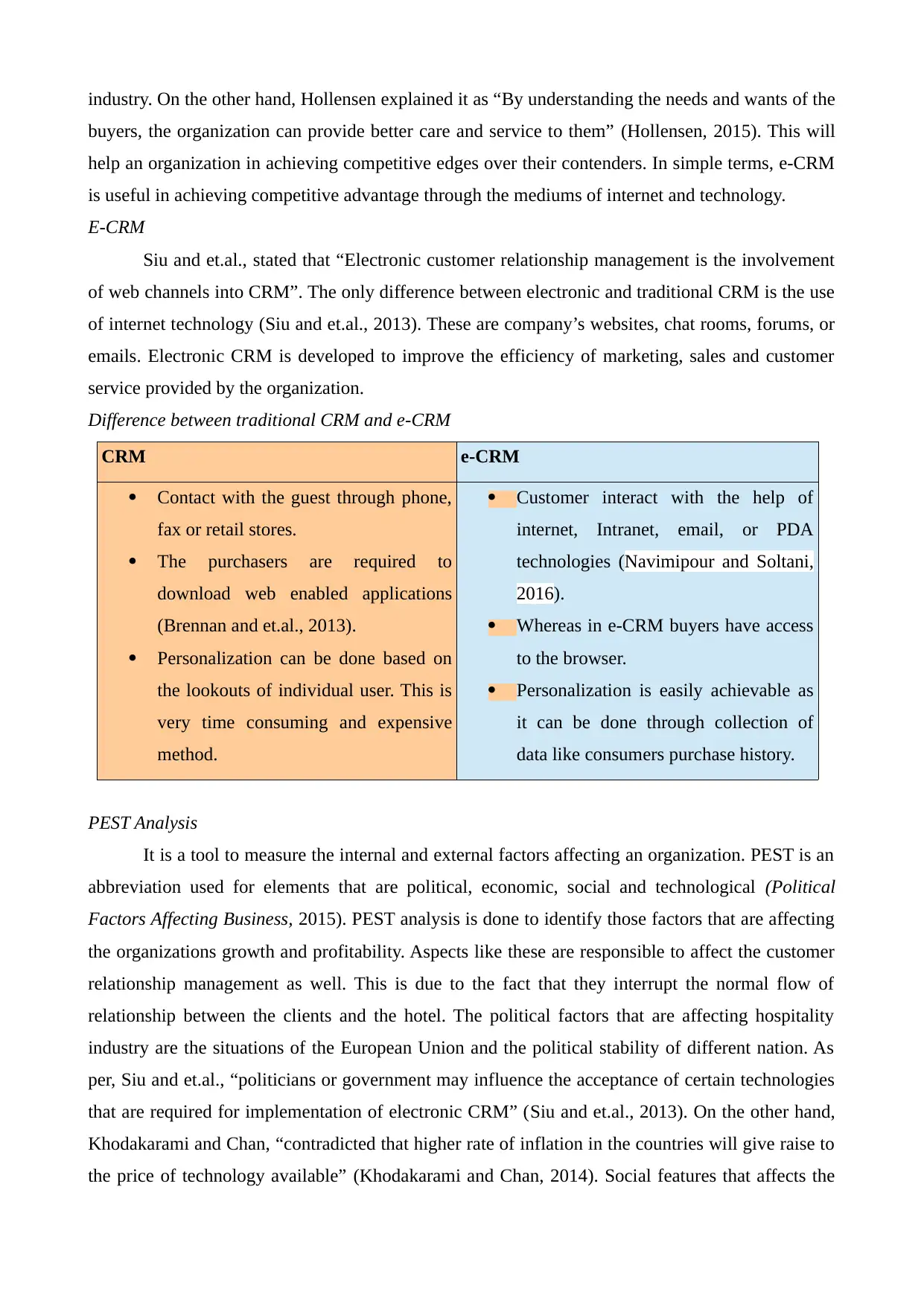
industry. On the other hand, Hollensen explained it as “By understanding the needs and wants of the
buyers, the organization can provide better care and service to them” (Hollensen, 2015). This will
help an organization in achieving competitive edges over their contenders. In simple terms, e-CRM
is useful in achieving competitive advantage through the mediums of internet and technology.
E-CRM
Siu and et.al., stated that “Electronic customer relationship management is the involvement
of web channels into CRM”. The only difference between electronic and traditional CRM is the use
of internet technology (Siu and et.al., 2013). These are company’s websites, chat rooms, forums, or
emails. Electronic CRM is developed to improve the efficiency of marketing, sales and customer
service provided by the organization.
Difference between traditional CRM and e-CRM
CRM e-CRM
Contact with the guest through phone,
fax or retail stores.
The purchasers are required to
download web enabled applications
(Brennan and et.al., 2013).
Personalization can be done based on
the lookouts of individual user. This is
very time consuming and expensive
method.
Customer interact with the help of
internet, Intranet, email, or PDA
technologies (Navimipour and Soltani,
2016).
Whereas in e-CRM buyers have access
to the browser.
Personalization is easily achievable as
it can be done through collection of
data like consumers purchase history.
PEST Analysis
It is a tool to measure the internal and external factors affecting an organization. PEST is an
abbreviation used for elements that are political, economic, social and technological (Political
Factors Affecting Business, 2015). PEST analysis is done to identify those factors that are affecting
the organizations growth and profitability. Aspects like these are responsible to affect the customer
relationship management as well. This is due to the fact that they interrupt the normal flow of
relationship between the clients and the hotel. The political factors that are affecting hospitality
industry are the situations of the European Union and the political stability of different nation. As
per, Siu and et.al., “politicians or government may influence the acceptance of certain technologies
that are required for implementation of electronic CRM” (Siu and et.al., 2013). On the other hand,
Khodakarami and Chan, “contradicted that higher rate of inflation in the countries will give raise to
the price of technology available” (Khodakarami and Chan, 2014). Social features that affects the
buyers, the organization can provide better care and service to them” (Hollensen, 2015). This will
help an organization in achieving competitive edges over their contenders. In simple terms, e-CRM
is useful in achieving competitive advantage through the mediums of internet and technology.
E-CRM
Siu and et.al., stated that “Electronic customer relationship management is the involvement
of web channels into CRM”. The only difference between electronic and traditional CRM is the use
of internet technology (Siu and et.al., 2013). These are company’s websites, chat rooms, forums, or
emails. Electronic CRM is developed to improve the efficiency of marketing, sales and customer
service provided by the organization.
Difference between traditional CRM and e-CRM
CRM e-CRM
Contact with the guest through phone,
fax or retail stores.
The purchasers are required to
download web enabled applications
(Brennan and et.al., 2013).
Personalization can be done based on
the lookouts of individual user. This is
very time consuming and expensive
method.
Customer interact with the help of
internet, Intranet, email, or PDA
technologies (Navimipour and Soltani,
2016).
Whereas in e-CRM buyers have access
to the browser.
Personalization is easily achievable as
it can be done through collection of
data like consumers purchase history.
PEST Analysis
It is a tool to measure the internal and external factors affecting an organization. PEST is an
abbreviation used for elements that are political, economic, social and technological (Political
Factors Affecting Business, 2015). PEST analysis is done to identify those factors that are affecting
the organizations growth and profitability. Aspects like these are responsible to affect the customer
relationship management as well. This is due to the fact that they interrupt the normal flow of
relationship between the clients and the hotel. The political factors that are affecting hospitality
industry are the situations of the European Union and the political stability of different nation. As
per, Siu and et.al., “politicians or government may influence the acceptance of certain technologies
that are required for implementation of electronic CRM” (Siu and et.al., 2013). On the other hand,
Khodakarami and Chan, “contradicted that higher rate of inflation in the countries will give raise to
the price of technology available” (Khodakarami and Chan, 2014). Social features that affects the
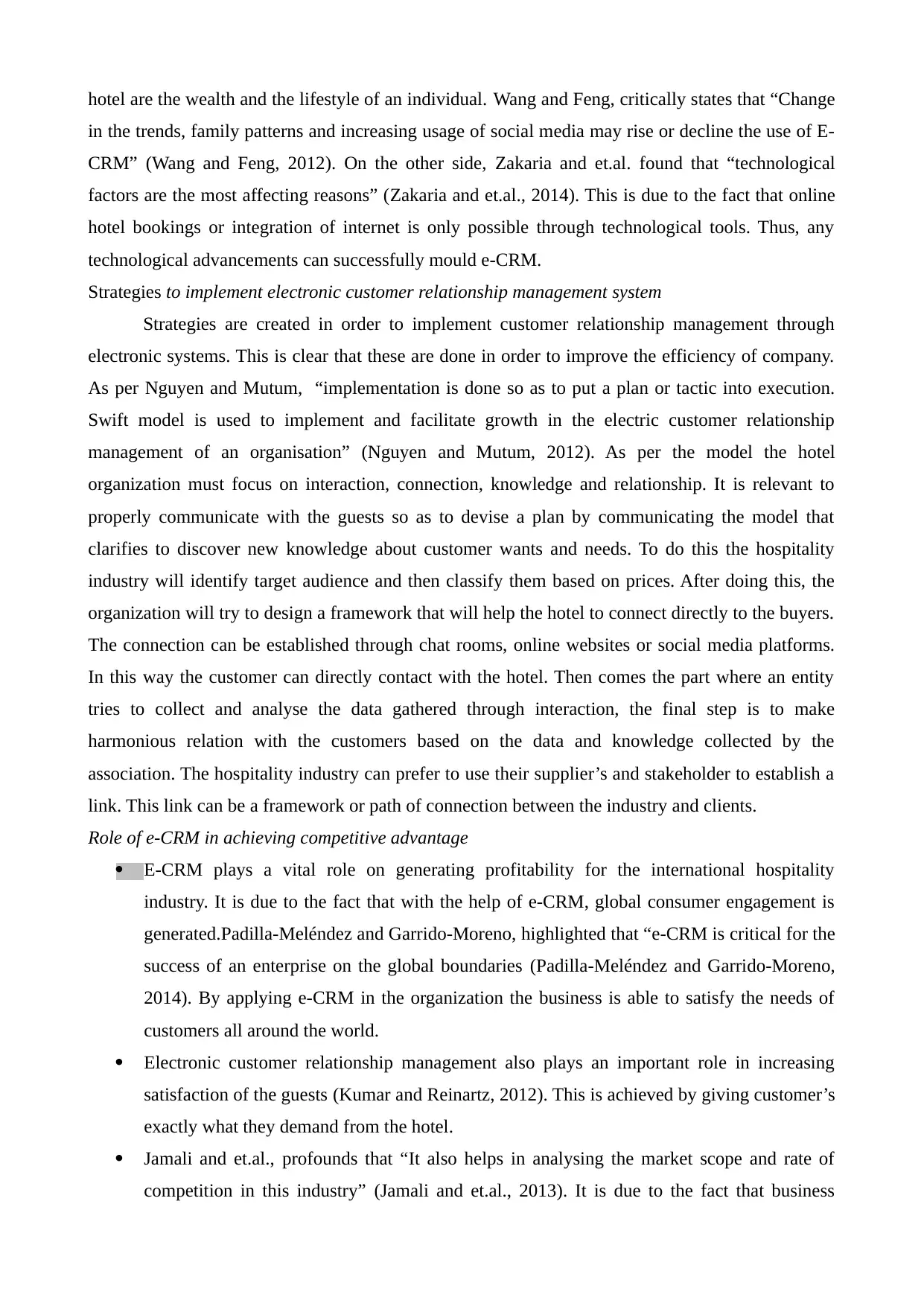
hotel are the wealth and the lifestyle of an individual. Wang and Feng, critically states that “Change
in the trends, family patterns and increasing usage of social media may rise or decline the use of E-
CRM” (Wang and Feng, 2012). On the other side, Zakaria and et.al. found that “technological
factors are the most affecting reasons” (Zakaria and et.al., 2014). This is due to the fact that online
hotel bookings or integration of internet is only possible through technological tools. Thus, any
technological advancements can successfully mould e-CRM.
Strategies to implement electronic customer relationship management system
Strategies are created in order to implement customer relationship management through
electronic systems. This is clear that these are done in order to improve the efficiency of company.
As per Nguyen and Mutum, “implementation is done so as to put a plan or tactic into execution.
Swift model is used to implement and facilitate growth in the electric customer relationship
management of an organisation” (Nguyen and Mutum, 2012). As per the model the hotel
organization must focus on interaction, connection, knowledge and relationship. It is relevant to
properly communicate with the guests so as to devise a plan by communicating the model that
clarifies to discover new knowledge about customer wants and needs. To do this the hospitality
industry will identify target audience and then classify them based on prices. After doing this, the
organization will try to design a framework that will help the hotel to connect directly to the buyers.
The connection can be established through chat rooms, online websites or social media platforms.
In this way the customer can directly contact with the hotel. Then comes the part where an entity
tries to collect and analyse the data gathered through interaction, the final step is to make
harmonious relation with the customers based on the data and knowledge collected by the
association. The hospitality industry can prefer to use their supplier’s and stakeholder to establish a
link. This link can be a framework or path of connection between the industry and clients.
Role of e-CRM in achieving competitive advantage
E-CRM plays a vital role on generating profitability for the international hospitality
industry. It is due to the fact that with the help of e-CRM, global consumer engagement is
generated.Padilla-Meléndez and Garrido-Moreno, highlighted that “e-CRM is critical for the
success of an enterprise on the global boundaries (Padilla-Meléndez and Garrido-Moreno,
2014). By applying e-CRM in the organization the business is able to satisfy the needs of
customers all around the world.
Electronic customer relationship management also plays an important role in increasing
satisfaction of the guests (Kumar and Reinartz, 2012). This is achieved by giving customer’s
exactly what they demand from the hotel.
Jamali and et.al., profounds that “It also helps in analysing the market scope and rate of
competition in this industry” (Jamali and et.al., 2013). It is due to the fact that business
in the trends, family patterns and increasing usage of social media may rise or decline the use of E-
CRM” (Wang and Feng, 2012). On the other side, Zakaria and et.al. found that “technological
factors are the most affecting reasons” (Zakaria and et.al., 2014). This is due to the fact that online
hotel bookings or integration of internet is only possible through technological tools. Thus, any
technological advancements can successfully mould e-CRM.
Strategies to implement electronic customer relationship management system
Strategies are created in order to implement customer relationship management through
electronic systems. This is clear that these are done in order to improve the efficiency of company.
As per Nguyen and Mutum, “implementation is done so as to put a plan or tactic into execution.
Swift model is used to implement and facilitate growth in the electric customer relationship
management of an organisation” (Nguyen and Mutum, 2012). As per the model the hotel
organization must focus on interaction, connection, knowledge and relationship. It is relevant to
properly communicate with the guests so as to devise a plan by communicating the model that
clarifies to discover new knowledge about customer wants and needs. To do this the hospitality
industry will identify target audience and then classify them based on prices. After doing this, the
organization will try to design a framework that will help the hotel to connect directly to the buyers.
The connection can be established through chat rooms, online websites or social media platforms.
In this way the customer can directly contact with the hotel. Then comes the part where an entity
tries to collect and analyse the data gathered through interaction, the final step is to make
harmonious relation with the customers based on the data and knowledge collected by the
association. The hospitality industry can prefer to use their supplier’s and stakeholder to establish a
link. This link can be a framework or path of connection between the industry and clients.
Role of e-CRM in achieving competitive advantage
E-CRM plays a vital role on generating profitability for the international hospitality
industry. It is due to the fact that with the help of e-CRM, global consumer engagement is
generated.Padilla-Meléndez and Garrido-Moreno, highlighted that “e-CRM is critical for the
success of an enterprise on the global boundaries (Padilla-Meléndez and Garrido-Moreno,
2014). By applying e-CRM in the organization the business is able to satisfy the needs of
customers all around the world.
Electronic customer relationship management also plays an important role in increasing
satisfaction of the guests (Kumar and Reinartz, 2012). This is achieved by giving customer’s
exactly what they demand from the hotel.
Jamali and et.al., profounds that “It also helps in analysing the market scope and rate of
competition in this industry” (Jamali and et.al., 2013). It is due to the fact that business
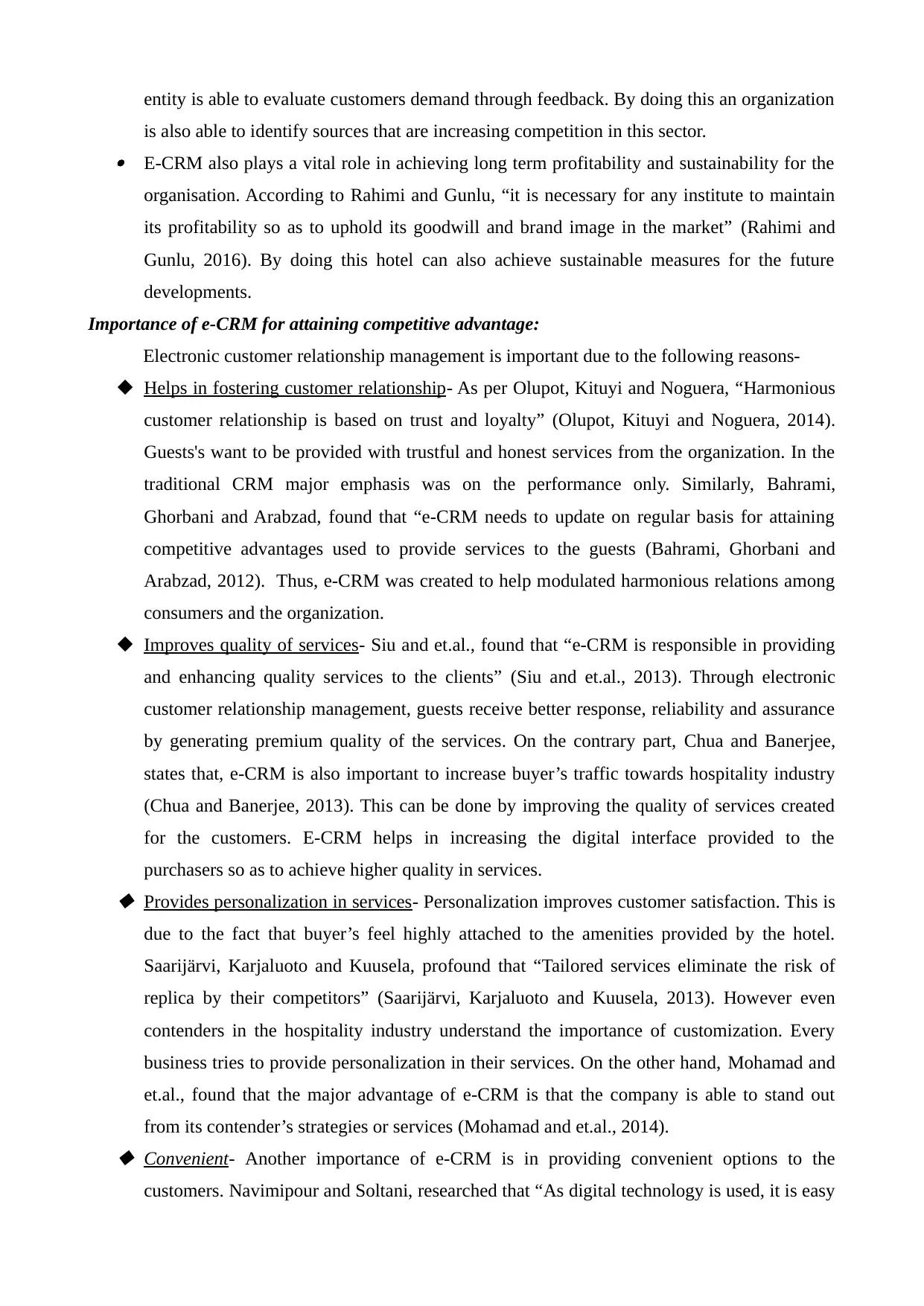
entity is able to evaluate customers demand through feedback. By doing this an organization
is also able to identify sources that are increasing competition in this sector. E-CRM also plays a vital role in achieving long term profitability and sustainability for the
organisation. According to Rahimi and Gunlu, “it is necessary for any institute to maintain
its profitability so as to uphold its goodwill and brand image in the market” (Rahimi and
Gunlu, 2016). By doing this hotel can also achieve sustainable measures for the future
developments.
Importance of e-CRM for attaining competitive advantage:
Electronic customer relationship management is important due to the following reasons-
Helps in fostering customer relationship- As per Olupot, Kituyi and Noguera, “Harmonious
customer relationship is based on trust and loyalty” (Olupot, Kituyi and Noguera, 2014).
Guests's want to be provided with trustful and honest services from the organization. In the
traditional CRM major emphasis was on the performance only. Similarly, Bahrami,
Ghorbani and Arabzad, found that “e-CRM needs to update on regular basis for attaining
competitive advantages used to provide services to the guests (Bahrami, Ghorbani and
Arabzad, 2012). Thus, e-CRM was created to help modulated harmonious relations among
consumers and the organization.
Improves quality of services- Siu and et.al., found that “e-CRM is responsible in providing
and enhancing quality services to the clients” (Siu and et.al., 2013). Through electronic
customer relationship management, guests receive better response, reliability and assurance
by generating premium quality of the services. On the contrary part, Chua and Banerjee,
states that, e-CRM is also important to increase buyer’s traffic towards hospitality industry
(Chua and Banerjee, 2013). This can be done by improving the quality of services created
for the customers. E-CRM helps in increasing the digital interface provided to the
purchasers so as to achieve higher quality in services. Provides personalization in services- Personalization improves customer satisfaction. This is
due to the fact that buyer’s feel highly attached to the amenities provided by the hotel.
Saarijärvi, Karjaluoto and Kuusela, profound that “Tailored services eliminate the risk of
replica by their competitors” (Saarijärvi, Karjaluoto and Kuusela, 2013). However even
contenders in the hospitality industry understand the importance of customization. Every
business tries to provide personalization in their services. On the other hand, Mohamad and
et.al., found that the major advantage of e-CRM is that the company is able to stand out
from its contender’s strategies or services (Mohamad and et.al., 2014). Convenient- Another importance of e-CRM is in providing convenient options to the
customers. Navimipour and Soltani, researched that “As digital technology is used, it is easy
is also able to identify sources that are increasing competition in this sector. E-CRM also plays a vital role in achieving long term profitability and sustainability for the
organisation. According to Rahimi and Gunlu, “it is necessary for any institute to maintain
its profitability so as to uphold its goodwill and brand image in the market” (Rahimi and
Gunlu, 2016). By doing this hotel can also achieve sustainable measures for the future
developments.
Importance of e-CRM for attaining competitive advantage:
Electronic customer relationship management is important due to the following reasons-
Helps in fostering customer relationship- As per Olupot, Kituyi and Noguera, “Harmonious
customer relationship is based on trust and loyalty” (Olupot, Kituyi and Noguera, 2014).
Guests's want to be provided with trustful and honest services from the organization. In the
traditional CRM major emphasis was on the performance only. Similarly, Bahrami,
Ghorbani and Arabzad, found that “e-CRM needs to update on regular basis for attaining
competitive advantages used to provide services to the guests (Bahrami, Ghorbani and
Arabzad, 2012). Thus, e-CRM was created to help modulated harmonious relations among
consumers and the organization.
Improves quality of services- Siu and et.al., found that “e-CRM is responsible in providing
and enhancing quality services to the clients” (Siu and et.al., 2013). Through electronic
customer relationship management, guests receive better response, reliability and assurance
by generating premium quality of the services. On the contrary part, Chua and Banerjee,
states that, e-CRM is also important to increase buyer’s traffic towards hospitality industry
(Chua and Banerjee, 2013). This can be done by improving the quality of services created
for the customers. E-CRM helps in increasing the digital interface provided to the
purchasers so as to achieve higher quality in services. Provides personalization in services- Personalization improves customer satisfaction. This is
due to the fact that buyer’s feel highly attached to the amenities provided by the hotel.
Saarijärvi, Karjaluoto and Kuusela, profound that “Tailored services eliminate the risk of
replica by their competitors” (Saarijärvi, Karjaluoto and Kuusela, 2013). However even
contenders in the hospitality industry understand the importance of customization. Every
business tries to provide personalization in their services. On the other hand, Mohamad and
et.al., found that the major advantage of e-CRM is that the company is able to stand out
from its contender’s strategies or services (Mohamad and et.al., 2014). Convenient- Another importance of e-CRM is in providing convenient options to the
customers. Navimipour and Soltani, researched that “As digital technology is used, it is easy
Paraphrase This Document
Need a fresh take? Get an instant paraphrase of this document with our AI Paraphraser
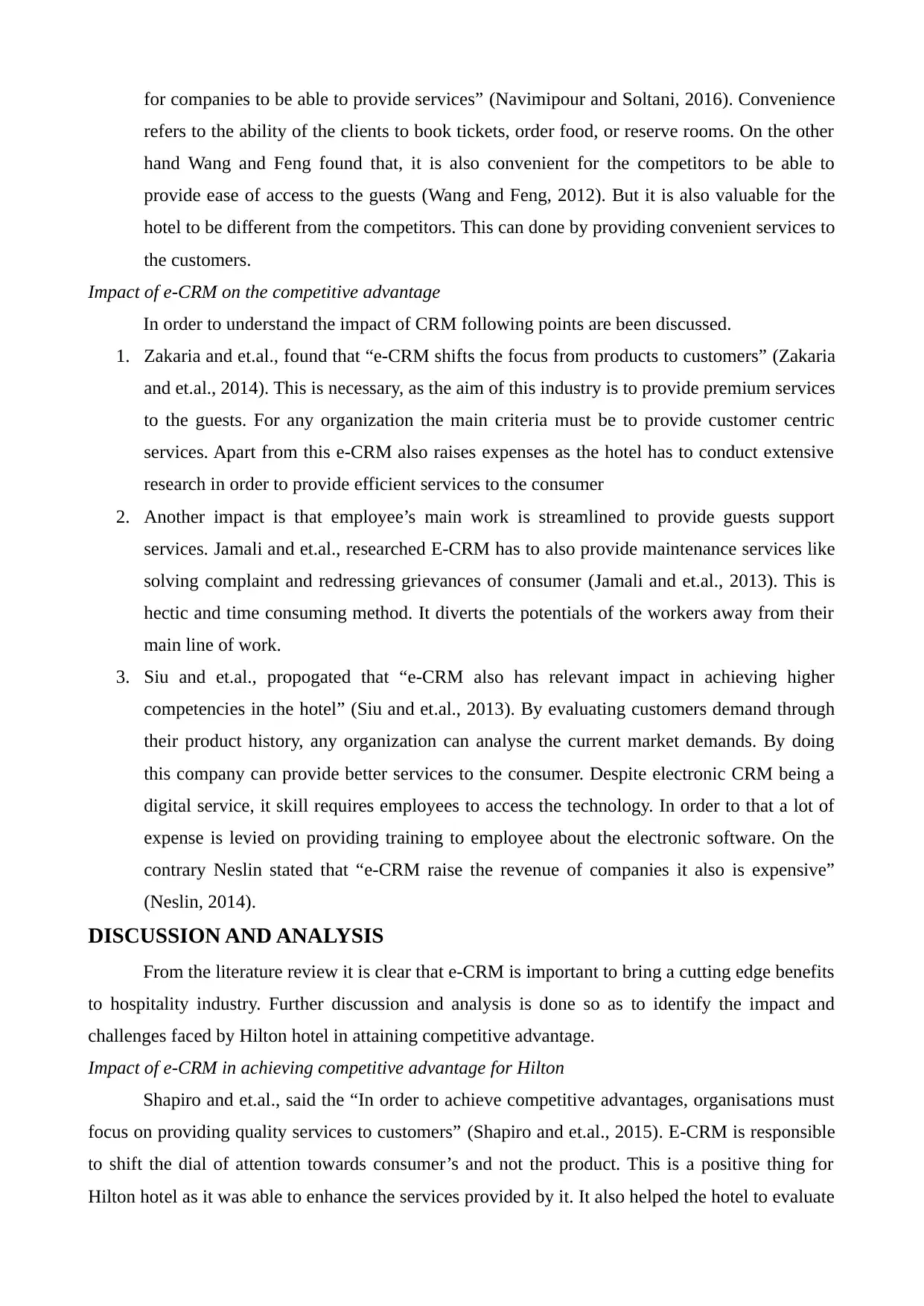
for companies to be able to provide services” (Navimipour and Soltani, 2016). Convenience
refers to the ability of the clients to book tickets, order food, or reserve rooms. On the other
hand Wang and Feng found that, it is also convenient for the competitors to be able to
provide ease of access to the guests (Wang and Feng, 2012). But it is also valuable for the
hotel to be different from the competitors. This can done by providing convenient services to
the customers.
Impact of e-CRM on the competitive advantage
In order to understand the impact of CRM following points are been discussed.
1. Zakaria and et.al., found that “e-CRM shifts the focus from products to customers” (Zakaria
and et.al., 2014). This is necessary, as the aim of this industry is to provide premium services
to the guests. For any organization the main criteria must be to provide customer centric
services. Apart from this e-CRM also raises expenses as the hotel has to conduct extensive
research in order to provide efficient services to the consumer
2. Another impact is that employee’s main work is streamlined to provide guests support
services. Jamali and et.al., researched E-CRM has to also provide maintenance services like
solving complaint and redressing grievances of consumer (Jamali and et.al., 2013). This is
hectic and time consuming method. It diverts the potentials of the workers away from their
main line of work.
3. Siu and et.al., propogated that “e-CRM also has relevant impact in achieving higher
competencies in the hotel” (Siu and et.al., 2013). By evaluating customers demand through
their product history, any organization can analyse the current market demands. By doing
this company can provide better services to the consumer. Despite electronic CRM being a
digital service, it skill requires employees to access the technology. In order to that a lot of
expense is levied on providing training to employee about the electronic software. On the
contrary Neslin stated that “e-CRM raise the revenue of companies it also is expensive”
(Neslin, 2014).
DISCUSSION AND ANALYSIS
From the literature review it is clear that e-CRM is important to bring a cutting edge benefits
to hospitality industry. Further discussion and analysis is done so as to identify the impact and
challenges faced by Hilton hotel in attaining competitive advantage.
Impact of e-CRM in achieving competitive advantage for Hilton
Shapiro and et.al., said the “In order to achieve competitive advantages, organisations must
focus on providing quality services to customers” (Shapiro and et.al., 2015). E-CRM is responsible
to shift the dial of attention towards consumer’s and not the product. This is a positive thing for
Hilton hotel as it was able to enhance the services provided by it. It also helped the hotel to evaluate
refers to the ability of the clients to book tickets, order food, or reserve rooms. On the other
hand Wang and Feng found that, it is also convenient for the competitors to be able to
provide ease of access to the guests (Wang and Feng, 2012). But it is also valuable for the
hotel to be different from the competitors. This can done by providing convenient services to
the customers.
Impact of e-CRM on the competitive advantage
In order to understand the impact of CRM following points are been discussed.
1. Zakaria and et.al., found that “e-CRM shifts the focus from products to customers” (Zakaria
and et.al., 2014). This is necessary, as the aim of this industry is to provide premium services
to the guests. For any organization the main criteria must be to provide customer centric
services. Apart from this e-CRM also raises expenses as the hotel has to conduct extensive
research in order to provide efficient services to the consumer
2. Another impact is that employee’s main work is streamlined to provide guests support
services. Jamali and et.al., researched E-CRM has to also provide maintenance services like
solving complaint and redressing grievances of consumer (Jamali and et.al., 2013). This is
hectic and time consuming method. It diverts the potentials of the workers away from their
main line of work.
3. Siu and et.al., propogated that “e-CRM also has relevant impact in achieving higher
competencies in the hotel” (Siu and et.al., 2013). By evaluating customers demand through
their product history, any organization can analyse the current market demands. By doing
this company can provide better services to the consumer. Despite electronic CRM being a
digital service, it skill requires employees to access the technology. In order to that a lot of
expense is levied on providing training to employee about the electronic software. On the
contrary Neslin stated that “e-CRM raise the revenue of companies it also is expensive”
(Neslin, 2014).
DISCUSSION AND ANALYSIS
From the literature review it is clear that e-CRM is important to bring a cutting edge benefits
to hospitality industry. Further discussion and analysis is done so as to identify the impact and
challenges faced by Hilton hotel in attaining competitive advantage.
Impact of e-CRM in achieving competitive advantage for Hilton
Shapiro and et.al., said the “In order to achieve competitive advantages, organisations must
focus on providing quality services to customers” (Shapiro and et.al., 2015). E-CRM is responsible
to shift the dial of attention towards consumer’s and not the product. This is a positive thing for
Hilton hotel as it was able to enhance the services provided by it. It also helped the hotel to evaluate
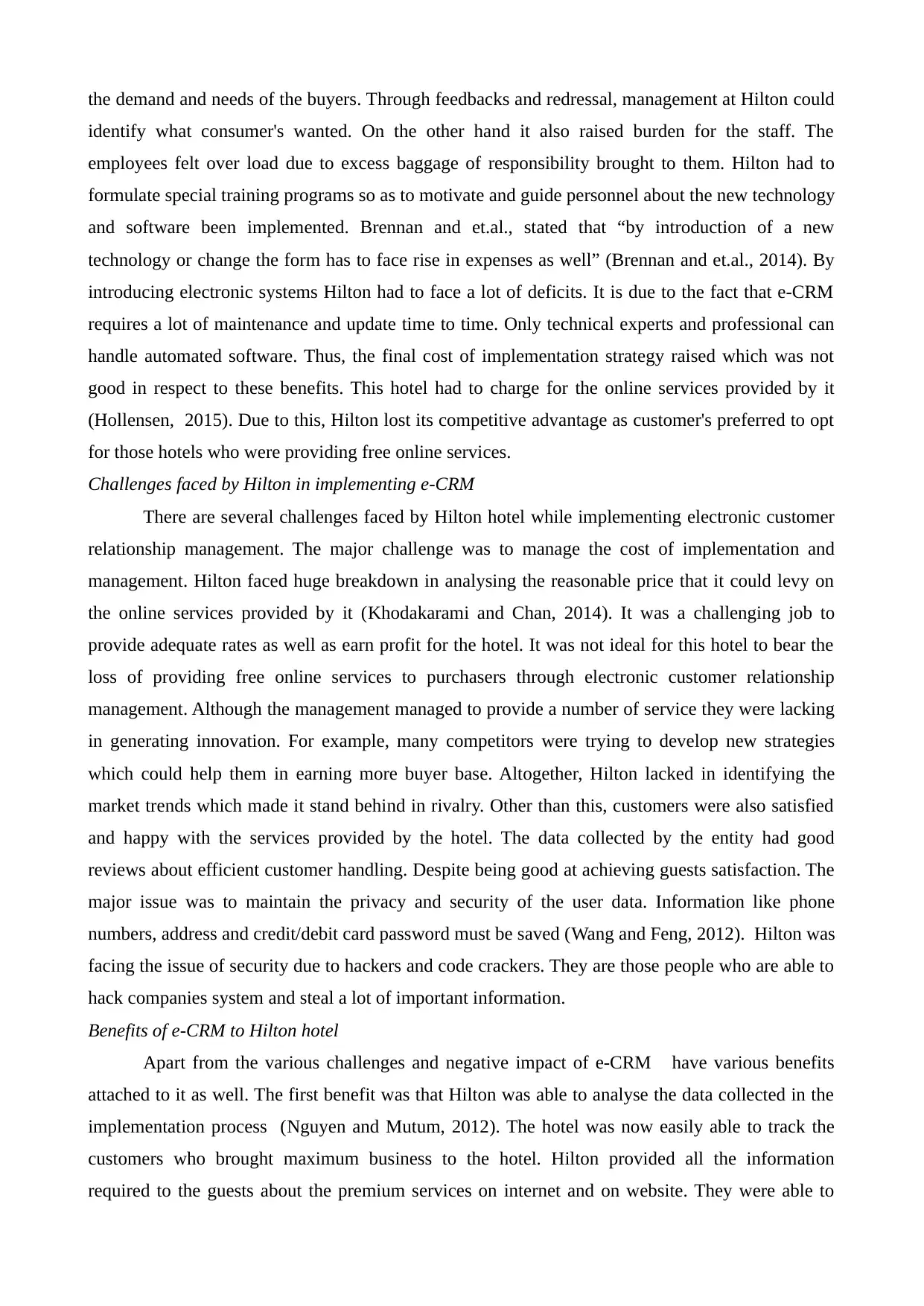
the demand and needs of the buyers. Through feedbacks and redressal, management at Hilton could
identify what consumer's wanted. On the other hand it also raised burden for the staff. The
employees felt over load due to excess baggage of responsibility brought to them. Hilton had to
formulate special training programs so as to motivate and guide personnel about the new technology
and software been implemented. Brennan and et.al., stated that “by introduction of a new
technology or change the form has to face rise in expenses as well” (Brennan and et.al., 2014). By
introducing electronic systems Hilton had to face a lot of deficits. It is due to the fact that e-CRM
requires a lot of maintenance and update time to time. Only technical experts and professional can
handle automated software. Thus, the final cost of implementation strategy raised which was not
good in respect to these benefits. This hotel had to charge for the online services provided by it
(Hollensen, 2015). Due to this, Hilton lost its competitive advantage as customer's preferred to opt
for those hotels who were providing free online services.
Challenges faced by Hilton in implementing e-CRM
There are several challenges faced by Hilton hotel while implementing electronic customer
relationship management. The major challenge was to manage the cost of implementation and
management. Hilton faced huge breakdown in analysing the reasonable price that it could levy on
the online services provided by it (Khodakarami and Chan, 2014). It was a challenging job to
provide adequate rates as well as earn profit for the hotel. It was not ideal for this hotel to bear the
loss of providing free online services to purchasers through electronic customer relationship
management. Although the management managed to provide a number of service they were lacking
in generating innovation. For example, many competitors were trying to develop new strategies
which could help them in earning more buyer base. Altogether, Hilton lacked in identifying the
market trends which made it stand behind in rivalry. Other than this, customers were also satisfied
and happy with the services provided by the hotel. The data collected by the entity had good
reviews about efficient customer handling. Despite being good at achieving guests satisfaction. The
major issue was to maintain the privacy and security of the user data. Information like phone
numbers, address and credit/debit card password must be saved (Wang and Feng, 2012). Hilton was
facing the issue of security due to hackers and code crackers. They are those people who are able to
hack companies system and steal a lot of important information.
Benefits of e-CRM to Hilton hotel
Apart from the various challenges and negative impact of e-CRM have various benefits
attached to it as well. The first benefit was that Hilton was able to analyse the data collected in the
implementation process (Nguyen and Mutum, 2012). The hotel was now easily able to track the
customers who brought maximum business to the hotel. Hilton provided all the information
required to the guests about the premium services on internet and on website. They were able to
identify what consumer's wanted. On the other hand it also raised burden for the staff. The
employees felt over load due to excess baggage of responsibility brought to them. Hilton had to
formulate special training programs so as to motivate and guide personnel about the new technology
and software been implemented. Brennan and et.al., stated that “by introduction of a new
technology or change the form has to face rise in expenses as well” (Brennan and et.al., 2014). By
introducing electronic systems Hilton had to face a lot of deficits. It is due to the fact that e-CRM
requires a lot of maintenance and update time to time. Only technical experts and professional can
handle automated software. Thus, the final cost of implementation strategy raised which was not
good in respect to these benefits. This hotel had to charge for the online services provided by it
(Hollensen, 2015). Due to this, Hilton lost its competitive advantage as customer's preferred to opt
for those hotels who were providing free online services.
Challenges faced by Hilton in implementing e-CRM
There are several challenges faced by Hilton hotel while implementing electronic customer
relationship management. The major challenge was to manage the cost of implementation and
management. Hilton faced huge breakdown in analysing the reasonable price that it could levy on
the online services provided by it (Khodakarami and Chan, 2014). It was a challenging job to
provide adequate rates as well as earn profit for the hotel. It was not ideal for this hotel to bear the
loss of providing free online services to purchasers through electronic customer relationship
management. Although the management managed to provide a number of service they were lacking
in generating innovation. For example, many competitors were trying to develop new strategies
which could help them in earning more buyer base. Altogether, Hilton lacked in identifying the
market trends which made it stand behind in rivalry. Other than this, customers were also satisfied
and happy with the services provided by the hotel. The data collected by the entity had good
reviews about efficient customer handling. Despite being good at achieving guests satisfaction. The
major issue was to maintain the privacy and security of the user data. Information like phone
numbers, address and credit/debit card password must be saved (Wang and Feng, 2012). Hilton was
facing the issue of security due to hackers and code crackers. They are those people who are able to
hack companies system and steal a lot of important information.
Benefits of e-CRM to Hilton hotel
Apart from the various challenges and negative impact of e-CRM have various benefits
attached to it as well. The first benefit was that Hilton was able to analyse the data collected in the
implementation process (Nguyen and Mutum, 2012). The hotel was now easily able to track the
customers who brought maximum business to the hotel. Hilton provided all the information
required to the guests about the premium services on internet and on website. They were able to
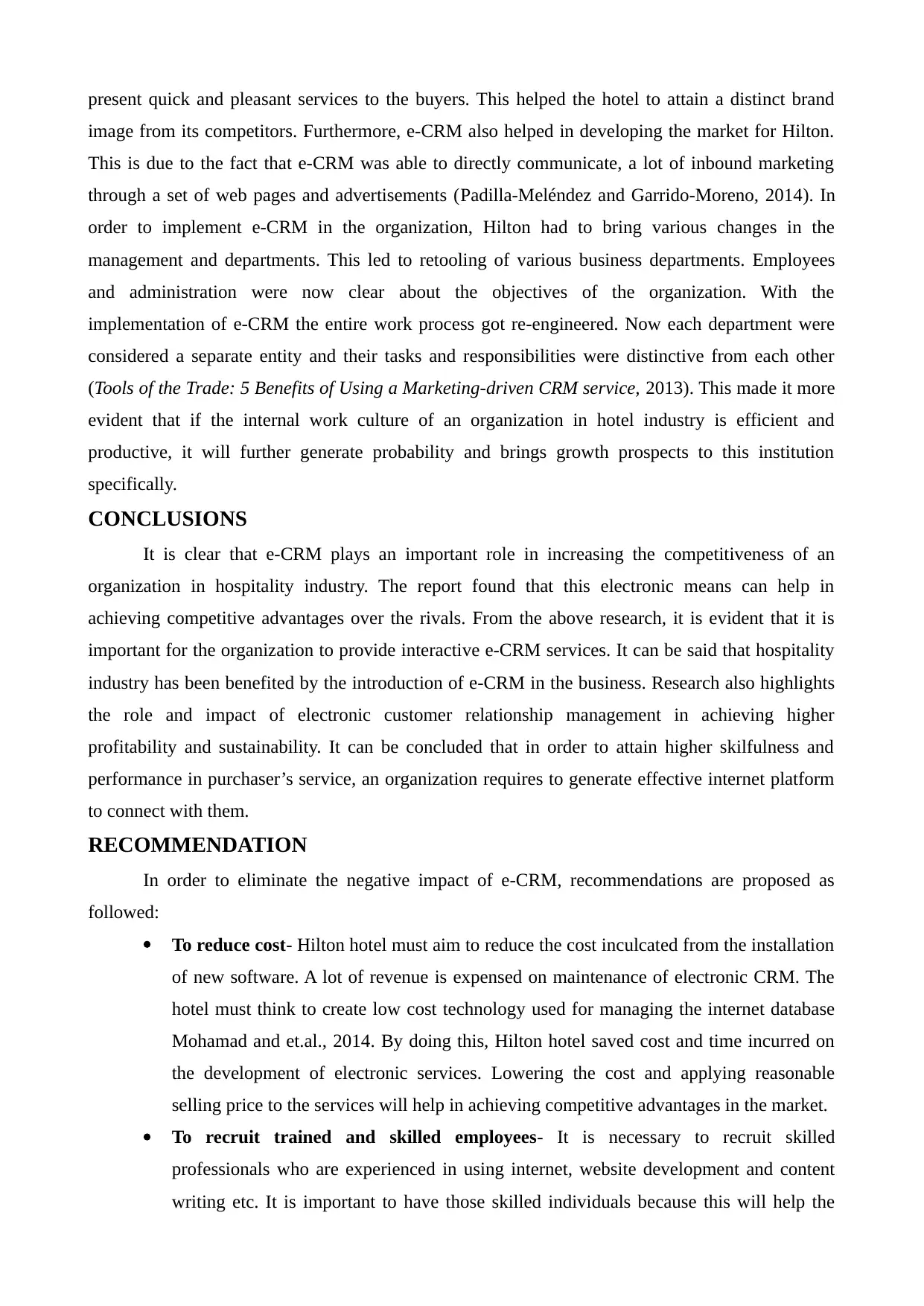
present quick and pleasant services to the buyers. This helped the hotel to attain a distinct brand
image from its competitors. Furthermore, e-CRM also helped in developing the market for Hilton.
This is due to the fact that e-CRM was able to directly communicate, a lot of inbound marketing
through a set of web pages and advertisements (Padilla-Meléndez and Garrido-Moreno, 2014). In
order to implement e-CRM in the organization, Hilton had to bring various changes in the
management and departments. This led to retooling of various business departments. Employees
and administration were now clear about the objectives of the organization. With the
implementation of e-CRM the entire work process got re-engineered. Now each department were
considered a separate entity and their tasks and responsibilities were distinctive from each other
(Tools of the Trade: 5 Benefits of Using a Marketing-driven CRM service, 2013). This made it more
evident that if the internal work culture of an organization in hotel industry is efficient and
productive, it will further generate probability and brings growth prospects to this institution
specifically.
CONCLUSIONS
It is clear that e-CRM plays an important role in increasing the competitiveness of an
organization in hospitality industry. The report found that this electronic means can help in
achieving competitive advantages over the rivals. From the above research, it is evident that it is
important for the organization to provide interactive e-CRM services. It can be said that hospitality
industry has been benefited by the introduction of e-CRM in the business. Research also highlights
the role and impact of electronic customer relationship management in achieving higher
profitability and sustainability. It can be concluded that in order to attain higher skilfulness and
performance in purchaser’s service, an organization requires to generate effective internet platform
to connect with them.
RECOMMENDATION
In order to eliminate the negative impact of e-CRM, recommendations are proposed as
followed:
To reduce cost- Hilton hotel must aim to reduce the cost inculcated from the installation
of new software. A lot of revenue is expensed on maintenance of electronic CRM. The
hotel must think to create low cost technology used for managing the internet database
Mohamad and et.al., 2014. By doing this, Hilton hotel saved cost and time incurred on
the development of electronic services. Lowering the cost and applying reasonable
selling price to the services will help in achieving competitive advantages in the market.
To recruit trained and skilled employees- It is necessary to recruit skilled
professionals who are experienced in using internet, website development and content
writing etc. It is important to have those skilled individuals because this will help the
image from its competitors. Furthermore, e-CRM also helped in developing the market for Hilton.
This is due to the fact that e-CRM was able to directly communicate, a lot of inbound marketing
through a set of web pages and advertisements (Padilla-Meléndez and Garrido-Moreno, 2014). In
order to implement e-CRM in the organization, Hilton had to bring various changes in the
management and departments. This led to retooling of various business departments. Employees
and administration were now clear about the objectives of the organization. With the
implementation of e-CRM the entire work process got re-engineered. Now each department were
considered a separate entity and their tasks and responsibilities were distinctive from each other
(Tools of the Trade: 5 Benefits of Using a Marketing-driven CRM service, 2013). This made it more
evident that if the internal work culture of an organization in hotel industry is efficient and
productive, it will further generate probability and brings growth prospects to this institution
specifically.
CONCLUSIONS
It is clear that e-CRM plays an important role in increasing the competitiveness of an
organization in hospitality industry. The report found that this electronic means can help in
achieving competitive advantages over the rivals. From the above research, it is evident that it is
important for the organization to provide interactive e-CRM services. It can be said that hospitality
industry has been benefited by the introduction of e-CRM in the business. Research also highlights
the role and impact of electronic customer relationship management in achieving higher
profitability and sustainability. It can be concluded that in order to attain higher skilfulness and
performance in purchaser’s service, an organization requires to generate effective internet platform
to connect with them.
RECOMMENDATION
In order to eliminate the negative impact of e-CRM, recommendations are proposed as
followed:
To reduce cost- Hilton hotel must aim to reduce the cost inculcated from the installation
of new software. A lot of revenue is expensed on maintenance of electronic CRM. The
hotel must think to create low cost technology used for managing the internet database
Mohamad and et.al., 2014. By doing this, Hilton hotel saved cost and time incurred on
the development of electronic services. Lowering the cost and applying reasonable
selling price to the services will help in achieving competitive advantages in the market.
To recruit trained and skilled employees- It is necessary to recruit skilled
professionals who are experienced in using internet, website development and content
writing etc. It is important to have those skilled individuals because this will help the
Secure Best Marks with AI Grader
Need help grading? Try our AI Grader for instant feedback on your assignments.
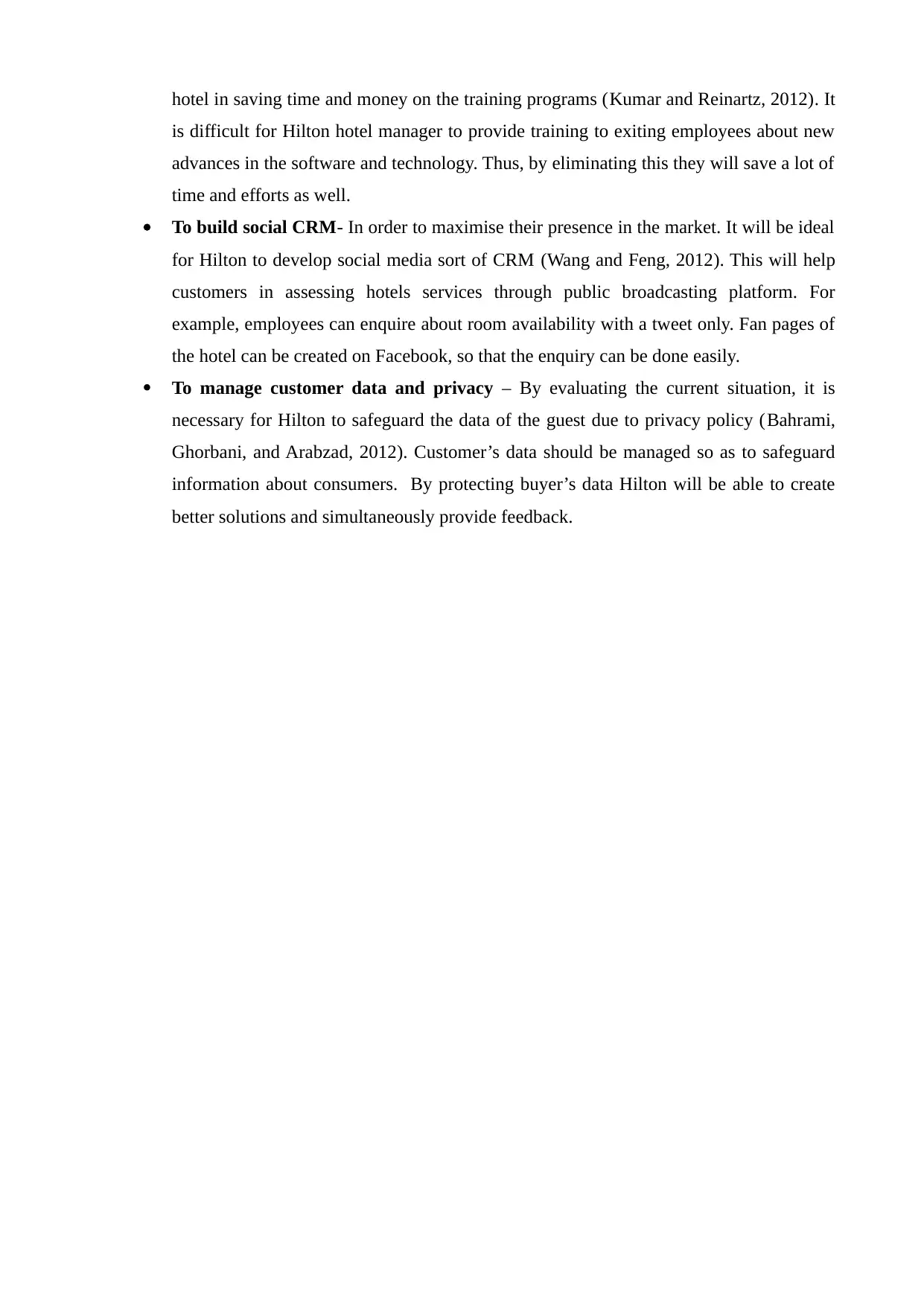
hotel in saving time and money on the training programs (Kumar and Reinartz, 2012). It
is difficult for Hilton hotel manager to provide training to exiting employees about new
advances in the software and technology. Thus, by eliminating this they will save a lot of
time and efforts as well.
To build social CRM- In order to maximise their presence in the market. It will be ideal
for Hilton to develop social media sort of CRM (Wang and Feng, 2012). This will help
customers in assessing hotels services through public broadcasting platform. For
example, employees can enquire about room availability with a tweet only. Fan pages of
the hotel can be created on Facebook, so that the enquiry can be done easily.
To manage customer data and privacy – By evaluating the current situation, it is
necessary for Hilton to safeguard the data of the guest due to privacy policy (Bahrami,
Ghorbani, and Arabzad, 2012). Customer’s data should be managed so as to safeguard
information about consumers. By protecting buyer’s data Hilton will be able to create
better solutions and simultaneously provide feedback.
is difficult for Hilton hotel manager to provide training to exiting employees about new
advances in the software and technology. Thus, by eliminating this they will save a lot of
time and efforts as well.
To build social CRM- In order to maximise their presence in the market. It will be ideal
for Hilton to develop social media sort of CRM (Wang and Feng, 2012). This will help
customers in assessing hotels services through public broadcasting platform. For
example, employees can enquire about room availability with a tweet only. Fan pages of
the hotel can be created on Facebook, so that the enquiry can be done easily.
To manage customer data and privacy – By evaluating the current situation, it is
necessary for Hilton to safeguard the data of the guest due to privacy policy (Bahrami,
Ghorbani, and Arabzad, 2012). Customer’s data should be managed so as to safeguard
information about consumers. By protecting buyer’s data Hilton will be able to create
better solutions and simultaneously provide feedback.
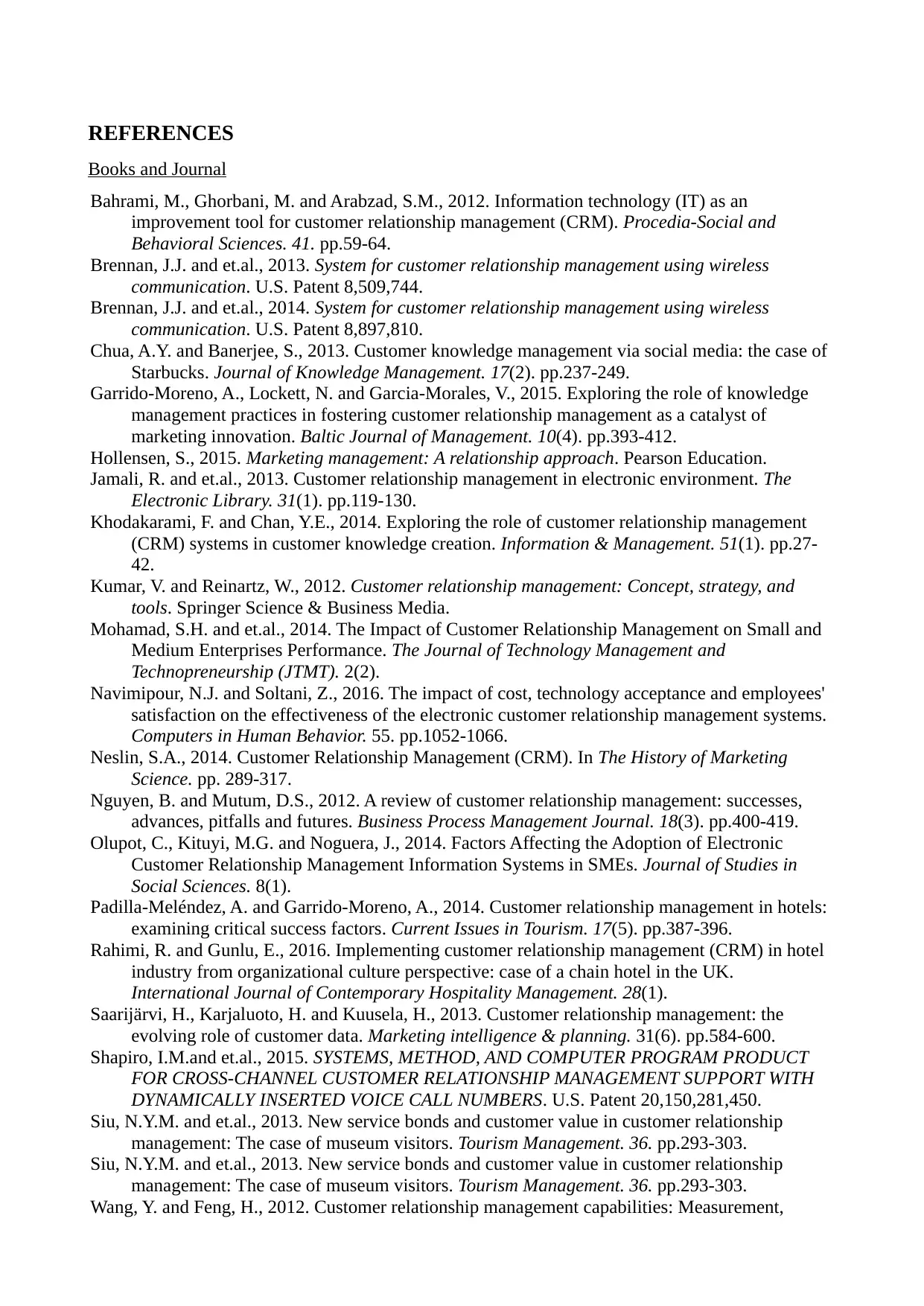
REFERENCES
Books and Journal
Bahrami, M., Ghorbani, M. and Arabzad, S.M., 2012. Information technology (IT) as an
improvement tool for customer relationship management (CRM). Procedia-Social and
Behavioral Sciences. 41. pp.59-64.
Brennan, J.J. and et.al., 2013. System for customer relationship management using wireless
communication. U.S. Patent 8,509,744.
Brennan, J.J. and et.al., 2014. System for customer relationship management using wireless
communication. U.S. Patent 8,897,810.
Chua, A.Y. and Banerjee, S., 2013. Customer knowledge management via social media: the case of
Starbucks. Journal of Knowledge Management. 17(2). pp.237-249.
Garrido-Moreno, A., Lockett, N. and Garcia-Morales, V., 2015. Exploring the role of knowledge
management practices in fostering customer relationship management as a catalyst of
marketing innovation. Baltic Journal of Management. 10(4). pp.393-412.
Hollensen, S., 2015. Marketing management: A relationship approach. Pearson Education.
Jamali, R. and et.al., 2013. Customer relationship management in electronic environment. The
Electronic Library. 31(1). pp.119-130.
Khodakarami, F. and Chan, Y.E., 2014. Exploring the role of customer relationship management
(CRM) systems in customer knowledge creation. Information & Management. 51(1). pp.27-
42.
Kumar, V. and Reinartz, W., 2012. Customer relationship management: Concept, strategy, and
tools. Springer Science & Business Media.
Mohamad, S.H. and et.al., 2014. The Impact of Customer Relationship Management on Small and
Medium Enterprises Performance. The Journal of Technology Management and
Technopreneurship (JTMT). 2(2).
Navimipour, N.J. and Soltani, Z., 2016. The impact of cost, technology acceptance and employees'
satisfaction on the effectiveness of the electronic customer relationship management systems.
Computers in Human Behavior. 55. pp.1052-1066.
Neslin, S.A., 2014. Customer Relationship Management (CRM). In The History of Marketing
Science. pp. 289-317.
Nguyen, B. and Mutum, D.S., 2012. A review of customer relationship management: successes,
advances, pitfalls and futures. Business Process Management Journal. 18(3). pp.400-419.
Olupot, C., Kituyi, M.G. and Noguera, J., 2014. Factors Affecting the Adoption of Electronic
Customer Relationship Management Information Systems in SMEs. Journal of Studies in
Social Sciences. 8(1).
Padilla-Meléndez, A. and Garrido-Moreno, A., 2014. Customer relationship management in hotels:
examining critical success factors. Current Issues in Tourism. 17(5). pp.387-396.
Rahimi, R. and Gunlu, E., 2016. Implementing customer relationship management (CRM) in hotel
industry from organizational culture perspective: case of a chain hotel in the UK.
International Journal of Contemporary Hospitality Management. 28(1).
Saarijärvi, H., Karjaluoto, H. and Kuusela, H., 2013. Customer relationship management: the
evolving role of customer data. Marketing intelligence & planning. 31(6). pp.584-600.
Shapiro, I.M.and et.al., 2015. SYSTEMS, METHOD, AND COMPUTER PROGRAM PRODUCT
FOR CROSS-CHANNEL CUSTOMER RELATIONSHIP MANAGEMENT SUPPORT WITH
DYNAMICALLY INSERTED VOICE CALL NUMBERS. U.S. Patent 20,150,281,450.
Siu, N.Y.M. and et.al., 2013. New service bonds and customer value in customer relationship
management: The case of museum visitors. Tourism Management. 36. pp.293-303.
Siu, N.Y.M. and et.al., 2013. New service bonds and customer value in customer relationship
management: The case of museum visitors. Tourism Management. 36. pp.293-303.
Wang, Y. and Feng, H., 2012. Customer relationship management capabilities: Measurement,
Books and Journal
Bahrami, M., Ghorbani, M. and Arabzad, S.M., 2012. Information technology (IT) as an
improvement tool for customer relationship management (CRM). Procedia-Social and
Behavioral Sciences. 41. pp.59-64.
Brennan, J.J. and et.al., 2013. System for customer relationship management using wireless
communication. U.S. Patent 8,509,744.
Brennan, J.J. and et.al., 2014. System for customer relationship management using wireless
communication. U.S. Patent 8,897,810.
Chua, A.Y. and Banerjee, S., 2013. Customer knowledge management via social media: the case of
Starbucks. Journal of Knowledge Management. 17(2). pp.237-249.
Garrido-Moreno, A., Lockett, N. and Garcia-Morales, V., 2015. Exploring the role of knowledge
management practices in fostering customer relationship management as a catalyst of
marketing innovation. Baltic Journal of Management. 10(4). pp.393-412.
Hollensen, S., 2015. Marketing management: A relationship approach. Pearson Education.
Jamali, R. and et.al., 2013. Customer relationship management in electronic environment. The
Electronic Library. 31(1). pp.119-130.
Khodakarami, F. and Chan, Y.E., 2014. Exploring the role of customer relationship management
(CRM) systems in customer knowledge creation. Information & Management. 51(1). pp.27-
42.
Kumar, V. and Reinartz, W., 2012. Customer relationship management: Concept, strategy, and
tools. Springer Science & Business Media.
Mohamad, S.H. and et.al., 2014. The Impact of Customer Relationship Management on Small and
Medium Enterprises Performance. The Journal of Technology Management and
Technopreneurship (JTMT). 2(2).
Navimipour, N.J. and Soltani, Z., 2016. The impact of cost, technology acceptance and employees'
satisfaction on the effectiveness of the electronic customer relationship management systems.
Computers in Human Behavior. 55. pp.1052-1066.
Neslin, S.A., 2014. Customer Relationship Management (CRM). In The History of Marketing
Science. pp. 289-317.
Nguyen, B. and Mutum, D.S., 2012. A review of customer relationship management: successes,
advances, pitfalls and futures. Business Process Management Journal. 18(3). pp.400-419.
Olupot, C., Kituyi, M.G. and Noguera, J., 2014. Factors Affecting the Adoption of Electronic
Customer Relationship Management Information Systems in SMEs. Journal of Studies in
Social Sciences. 8(1).
Padilla-Meléndez, A. and Garrido-Moreno, A., 2014. Customer relationship management in hotels:
examining critical success factors. Current Issues in Tourism. 17(5). pp.387-396.
Rahimi, R. and Gunlu, E., 2016. Implementing customer relationship management (CRM) in hotel
industry from organizational culture perspective: case of a chain hotel in the UK.
International Journal of Contemporary Hospitality Management. 28(1).
Saarijärvi, H., Karjaluoto, H. and Kuusela, H., 2013. Customer relationship management: the
evolving role of customer data. Marketing intelligence & planning. 31(6). pp.584-600.
Shapiro, I.M.and et.al., 2015. SYSTEMS, METHOD, AND COMPUTER PROGRAM PRODUCT
FOR CROSS-CHANNEL CUSTOMER RELATIONSHIP MANAGEMENT SUPPORT WITH
DYNAMICALLY INSERTED VOICE CALL NUMBERS. U.S. Patent 20,150,281,450.
Siu, N.Y.M. and et.al., 2013. New service bonds and customer value in customer relationship
management: The case of museum visitors. Tourism Management. 36. pp.293-303.
Siu, N.Y.M. and et.al., 2013. New service bonds and customer value in customer relationship
management: The case of museum visitors. Tourism Management. 36. pp.293-303.
Wang, Y. and Feng, H., 2012. Customer relationship management capabilities: Measurement,
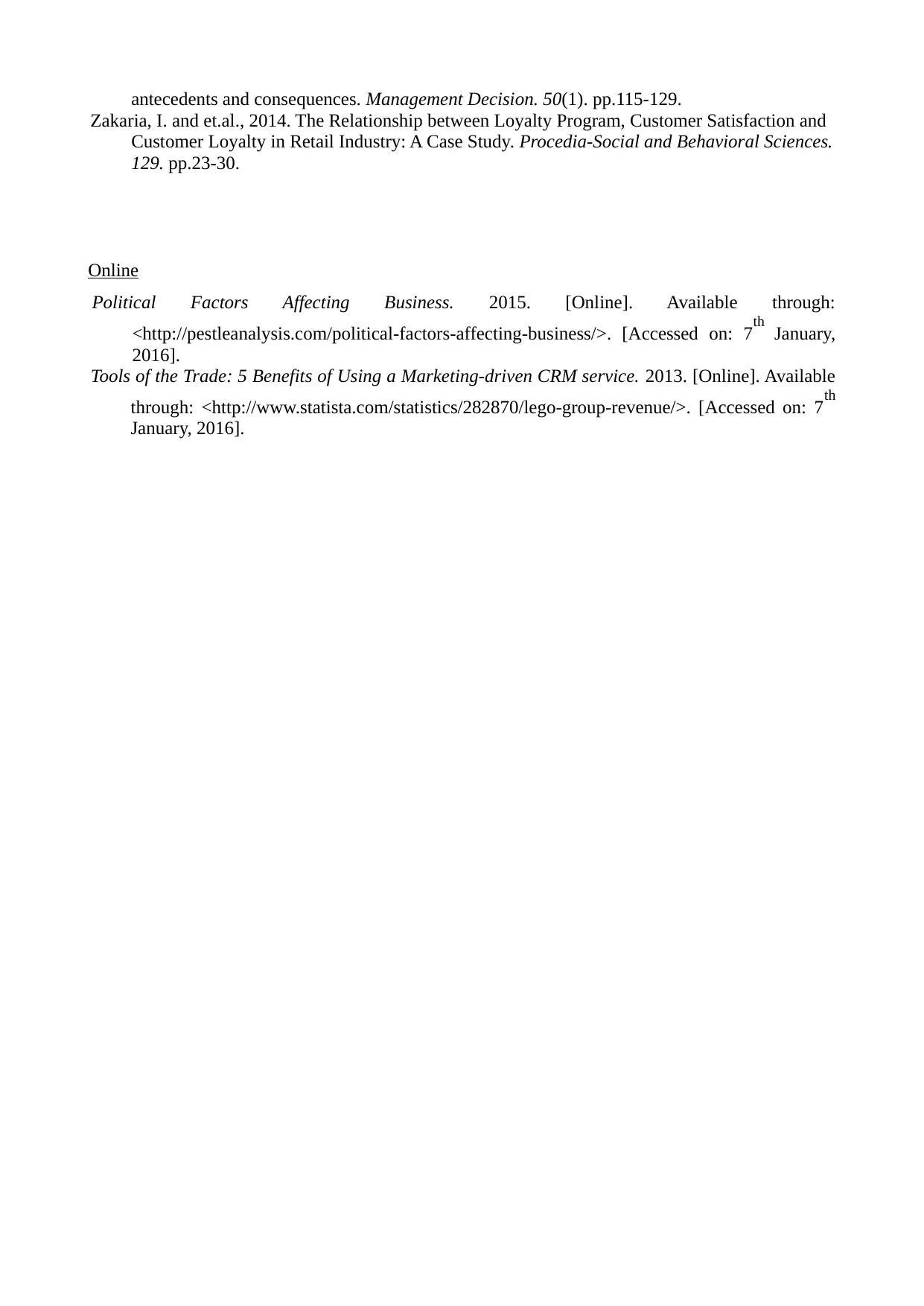
antecedents and consequences. Management Decision. 50(1). pp.115-129.
Zakaria, I. and et.al., 2014. The Relationship between Loyalty Program, Customer Satisfaction and
Customer Loyalty in Retail Industry: A Case Study. Procedia-Social and Behavioral Sciences.
129. pp.23-30.
Online
Political Factors Affecting Business. 2015. [Online]. Available through:
<http://pestleanalysis.com/political-factors-affecting-business/>. [Accessed on: 7th January,
2016].
Tools of the Trade: 5 Benefits of Using a Marketing-driven CRM service. 2013. [Online]. Available
through: <http://www.statista.com/statistics/282870/lego-group-revenue/>. [Accessed on: 7th
January, 2016].
Zakaria, I. and et.al., 2014. The Relationship between Loyalty Program, Customer Satisfaction and
Customer Loyalty in Retail Industry: A Case Study. Procedia-Social and Behavioral Sciences.
129. pp.23-30.
Online
Political Factors Affecting Business. 2015. [Online]. Available through:
<http://pestleanalysis.com/political-factors-affecting-business/>. [Accessed on: 7th January,
2016].
Tools of the Trade: 5 Benefits of Using a Marketing-driven CRM service. 2013. [Online]. Available
through: <http://www.statista.com/statistics/282870/lego-group-revenue/>. [Accessed on: 7th
January, 2016].
1 out of 13
Related Documents
Your All-in-One AI-Powered Toolkit for Academic Success.
+13062052269
info@desklib.com
Available 24*7 on WhatsApp / Email
![[object Object]](/_next/static/media/star-bottom.7253800d.svg)
Unlock your academic potential
© 2024 | Zucol Services PVT LTD | All rights reserved.





